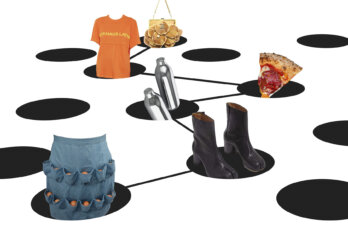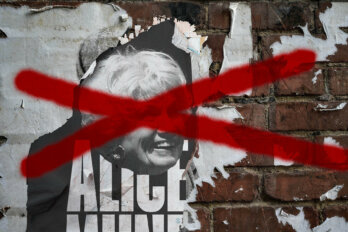The world has been ravaged by a plague that has turned anyone with enough testosterone into a cannibalistic automaton. Beth and Fran, two trans women, fight to survive in this wasteland, battling extremist TERFs (trans-exclusionary radical feminists) while harvesting the testicles of zombified men—a reliable source of estrogen. Manhunt, Gretchen Felker-Martin’s new novel, is brutal and gory. Cutting open one of the infested, Fran finds “squirming tumors that flinched from her hunting knife and scalpel, hiding among bones and fleshy membranes like goldfish in the archways and battlements of an aquarium castle.” This is poetry in extremis. It’s also among the best in contemporary horror.
The genre is having a moment, whether it’s film (like Jordan Peele’s high-grossing Get Out), podcasts (such as the pop-supernatural Lore), or TV (including Netflix hits like The Haunting of Hill House). Publishers are taking notice with new imprints. Last fall, major sci-fi and fantasy publisher Tor Books—which put out Robert Jordan’s famed series The Wheel of Time, now an Amazon Prime show—launched a horror imprint, and Manhunt is one of the most talked-about titles in its lineup. (NPR called it “brilliantly imagined,” and Publisher’s Weekly admired how it “swings for the fences.”) Under its imprint Strange Light, Penguin Random House Canada started publishing horror novels in 2019, including David Demchuk’s Red X, in which a monster haunts and hunts Toronto’s Gay Village. (Demchuk’s 2017 horror debut, The Bone Mother, was a number-one bestseller on Amazon.) Farrar, Straus and Giroux has had major success with its line of FSG Originals, particularly Jeff VanderMeer’s sci-fi horror novel Annihilation, which was recently adapted into a movie starring Natalie Portman. Literary prizes are also paying more attention. Stephen Graham Jones, a Blackfeet writer, won the 2021 Mark Twain American Voice in Literature Award for The Only Good Indians—a grisly supernatural revenge tale. Previous winners include literary luminaries Ocean Vuong and T. C. Boyle. Jones has been publishing since the early aughts; the wider culture is only now catching up.
The familiar story is that horror fiction boomed in the seventies and eighties. Cashing in on the success of blockbusters like The Exorcist, publishers pumped out gaudy die-cut paperbacks for over a decade, some of them stellar, most of them grist for the pulp mill—sexist, stereotypical, clichéd, wooden. The boom died in the nineties, killed by a glutted market and psycho crime thrillers (chianti and fava beans, anyone?). Horror became a bad word. Bookstores shed their horror sections as the public lost its appetite for covers of jogging skeletons and giant crabs.
But readers seem to be rediscovering their taste for horror. According to Publisher’s Weekly, NPD BookScan, a leading data firm, reported a 16.6 percent jump in sales for 2019. The next year, Goodreads, maybe the world’s biggest site for book recommendations, declared that the genre was “suddenly among each month’s most anticipated books.” The industry isn’t settling for simple spine-tinglers either. It wants nuance, diversity, a reckoning with difficult subjects. In turn, authors are rediscovering the possibilities of the genre. Plots explore, often in nuanced ways, toxic masculinity, gender roles in conventional marriage, and mental illness. They examine Indigeneity, queer abuse, and the predatory nature of reality TV. The only common denominator is quality: contemporary authors scare us while tending to their sentences. Take this line from Demchuk: “All around the city, past and present entwine like lazy lovers as the last light fades.” Balanced, taut, a merger of abstraction and specificity that clicks like a lock. That alliterative flourish is almost too much—it flirts with excess—but, in the end, just enough. Compare it to this line from eighties mainstay J. N. Williamson: “In more or less direct and characteristic rebuttal to the lusty wind and splotches of drab snow and ice stubbornly clinging to State Road 475, the driver dipped his right toe and coaxed a risky burst of further speed from the aging vehicle.” Lusty wind? The less said about that, the better.
Granted, not all Reagan-era chillers read like this. Horror giant Peter Straub sat at the feet of Henry James and did more than any other author to establish the genre’s literary bona fides. And, as genre silos continue to break down, more writers are using horror to create uncategorizable work. Toronto’s Naben Ruthnum, who wrote two thrillers under his pen name, Nathan Ripley, recently published a horror novella called Helpmeet with Undertow Publications—a small operation out of Pickering, Ontario. Undertow leans toward authors good at creating stomach-turning narratives through subtlety and lyricism, and Helpmeet narrates the complicated marriage between a deteriorating Edward and his loyal wife Louise. The book weds late Victorian restraint to modern horror effects, creating a nasty polished jewel—a lot like the tiny fingernail Louise finds growing from Edward’s empty eye socket. Or take American author Brian Evenson, whose postmodern horror stories sound like no one else. In 2016, The New Yorker ran a profile of Evenson that called his fiction “equal parts obsessive, experimental, and violent.” His off-kilter sentences, with their doublings and qualifiers, ensure the reader is never on firm footing:
A 2019 article in the Toronto Star links horror’s growing popularity to the screen: canny TV and film adaptations are drawing audiences back to a shunned genre. A valid point, but something else is in the well water too. Here’s Stephen King in Danse Macabre, his survey of horror culture from the fifties to the eighties: “The horror genre has often been able to find national phobic pressure points, and those books and films which have been the most successful almost always seem to play upon and express fears which exist across a wide spectrum of people.” Much like how Mary Shelley’s 1818 Frankenstein was a commentary on scientific hubris, the fifties gave us nuke-mutated bugs and McCarthyist nightmares. Political upheavals during the sixties were allegorized by the zombies that staggered through Night of the Living Dead while the haunted houses in the seventies reflected the era’s financial fears. One could argue that the eighties were all about the children, with mass hysteria over satanic rituals and the spiritual dangers of Dungeons and Dragons.
Art doesn’t always cop to such a simple one-to-one formula, which King concedes. The best horror transcends easy readings. The Shining is about many things, as Rodney Ascher proves in his documentary Room 237, trotting out an army of interpreters who think they hold the truth about Stanley Kubrick’s film adaptation. It would also be wrong to think there was no great horror after the boom—in the nineties, Thomas Ligotti was writing existential dreamscapes where alienated characters yearned for “the paradise of the unborn.” But we’re now afflicted by so many phobic pressure points that we’re almost in traction. We live in world where a global pandemic is denied daily by those in power, where the threat of nuclear war looms (again), where we may have passed the tipping point for total climate disaster, where housing bubbles threaten to flatten our cities, where scores of workers are trapped in a gig economy, overzoomed and underpaid. No wonder horror is booming.
Michael Kelly, who runs Undertow, underlines horror’s sociopolitical sophistication, its unique ability to address contemporary problems. “Horror fiction is finally moving away from the fear of the other and is focusing more on an examination of our societal anxieties in more nuanced ways.”
The shadow of H. P. Lovecraft looms over Kelly’s comments. Arguably the most influential and problematic horror writer of the twentieth century, Lovecraft could be radically inventive, yet many of his monsters were thin covers for the immigrants and marginalized people he openly reviled. In an early essay, Stephen King states that “the horror movie is innately conservative, even reactionary.” With Lovecraft’s legacy in mind, one could say the same for the horror novel. Demchuk wrestles with this sentiment in one of Red X’s essayistic asides. Placing himself in the narrative, he writes about queerness in horror while grappling with the regressive values the genre upholds. “As I write in the genre, I continually have to question whether I am demonizing sides of myself that I should be embracing and celebrating: my values, my relationships, my sexuality, my otherness.” In Manhunt, Felker-Martin complicates horror’s conservative binaries by upending traditional definitions of the monster. On the surface, the infected men with their splitting skin and animalistic behaviour are undoubtedly monstrous, but the militant TERFs systematically executing trans people in this ravaged world are the true horrors.
With their formal risks and their willingness to question horror’s foundations, writers like Demchuk and Felker-Martin are shedding the genre’s very cis, very straight, very male foundations. But Hamilton author Andrew F. Sullivan, who has two horror titles forthcoming, cautions us from seeing horror simply as a way to artistically cope with or challenge society’s own monstrosities. Rather, he says the best horror and weird fiction solves nothing. It is an enacted helplessness relevant to these times. “It makes you sit with all you can’t know,” he says, “your inability to act or change, the reality of a world that has no use for you.”
Laird Barron’s celebrated novella “—30—,” set on a defunct commune owned by a sinister cult, starts like this: “You know how this is going to end.” But we don’t, not really. In the best horror stories, good doesn’t always win out, expectations aren’t confirmed, the balance isn’t set, if only because an unfeeling cosmos has its thumb on the scale. In Red X, the whole city of Toronto becomes a haunted house populated by disappeared gay men and the homophobic public that ignores them. In the end, evil might be better understood, but it isn’t defeated; people are still disappearing, and the monsters “are just out of sight.”
I know every generation says this, but ours is more fractious, more divisive, more pissed. We’re a zombie story; we’re a plague story; we’re robots run amok. Perhaps this is the best time for the genre because it is an awful time for us.





